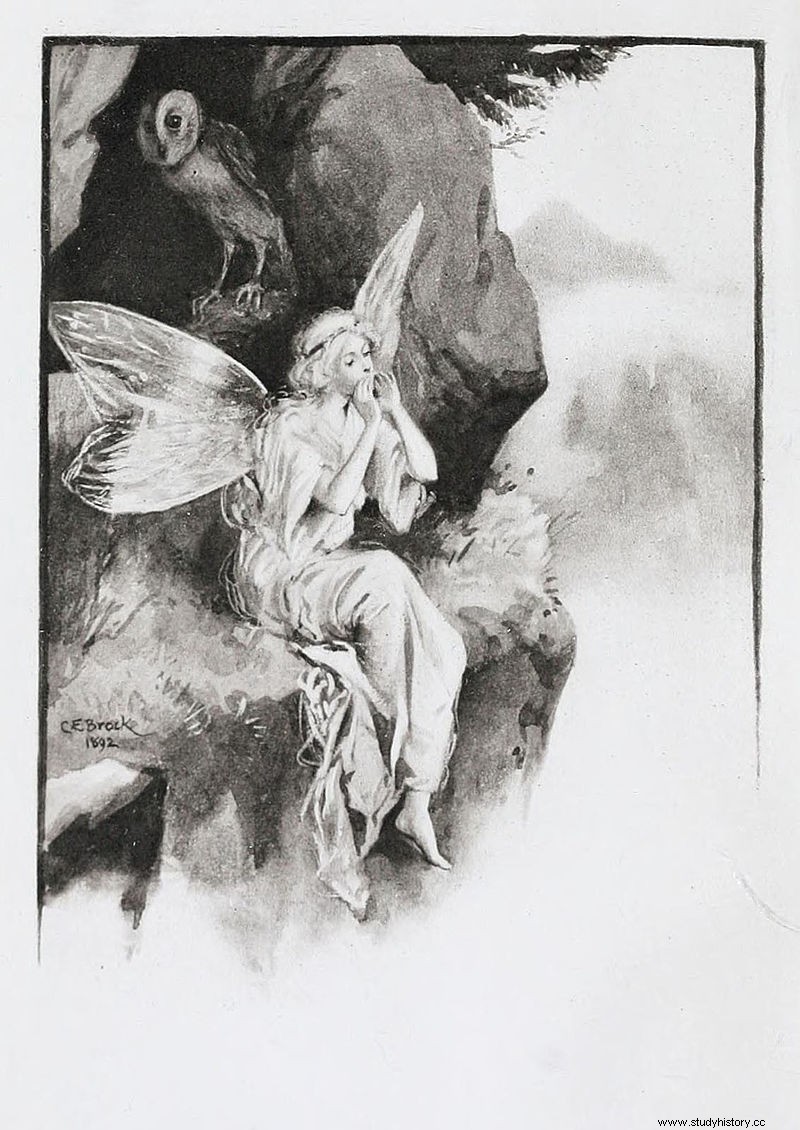
Illustration of a fairy by CE Brock (public domain)
Pheology (Faroese) Study of Fear
Fairies have always been with us. From our earliest prehistoric origins, humanity as a species has always been interested in the invisible realm.
Curiosity nourishes the imagination with depictions of supernatural beings who can either be friends or enemies. At the heart of these images are stories that form the backbone of folklore and mythology. Across time and culture, the names change, but the essence remains the same. Despite all the commonality that these stories have, fairies are much more diverse than humanity could ever imagine. Our mythical representations fall short in defining who or what a fairy really is.
How do we define fairy (fe) ?
Defining fairies is not as easy as it seems. Limiting the meaning to a small, feminine, benevolent, winged being is too simple an interpretation. While doing my own research, I have learned that there is more than one type of fairy, and some of them can mix with others, creating a variety of beings that may or may not fit into our accepted paradigm.
What is the significance of fairies in society?
In most stories about fairies and other related forms (ie:elves, goblins, fairies) they are sometimes useful for humans or out to make life miserable in some way (eg:Rumpelstiltskin). Along with their mischief and mystery, fairies serve as a form of hope; a desire for something better or different that we can strive for in our worldly world.
Studying fairies allows us to understand ourselves. The human imagination makes us unique in the animal kingdom. This is not to say that other animals have no imagination, but that we - as the so-called higher order, are able to take what we imagine and expand it with the help of art, literature, music, etc. Fairy tales, folk tales and myths teaches us how to explain phenomena, seek guidance, take responsibility for our own actions and navigate the world through our unique cultural narrative.
Is pheology (pheology) proper name for our practice?
The study of mythical beings falls under the umbrella term mythology. We consider fairies to be mythical beings who fall into the mentioned category. Fairies are just one type of being that this broad classification covers. The problem with the term is that it is too broad and does not specifically refer to the realm of fairies, which is the proper name of fairies and their world. For example, the creature known as Sasquatch is a cryptid, and the study of these types of beings is called cryptozoology, just as the study of UFOs is called Ufology, and therefore I feel that the study of fairies should be called "fairyology" or at. least pheology.
I will explain the terms fairy, fairy and fairy as you read on in this discourse.
The definition of the term SCULFT and how does it help to expand our paradigm of fairies?
Finally, we will study and define fairy in the context of SCULFT, which is a term I have created to refer to my research on this topic and others similar. SCULFT stands for sub-cultures, urban legends and folk tales (fairy tales). I put these subjects together because they provide a rich source of knowledge and information outside of the accepted mainstream literature.
Define Fairy
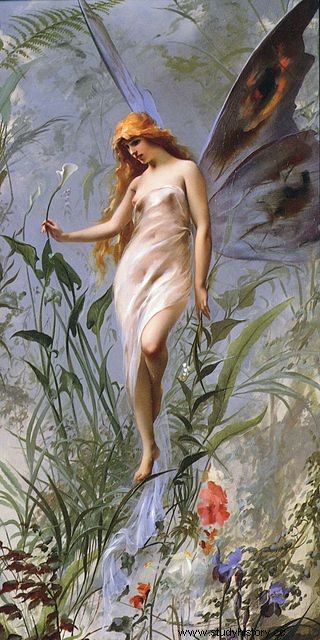
Illustration of a Fairy by Luis Ricardo Falero, 1888 (public property)
F airy (Faerie)
The word fe evokes a variety of images that include winged, magical creatures that can be friendly or evil. We understand the imagery, but the word itself applies to so many different types of creatures that it can be difficult to define. In this text I use the word fe as an alternative to the traditional spelling to denote the diversity of beings and also to refer to the "kingdom of fairies". Therefore, I will use the words fairy and fairy alternately.
Basic definition -
1) A small winged creature with magical powers.
2) A tiny mythical creature from folklore.
3) A smart and sometimes mischievous creature that has magical powers.
Synonyms- Brownie, fae, elf, sprite, nisse, troll, gnome, puka, pyke, wee folk, duende, the good people and leprechaun.
Broad Definition-
A fairy is any being who has powers and abilities beyond the natural human world. The powers that fairies have can be called supernatural or supernatural. This means that their forces are not subject to physics (time, space, etc.) and the laws of our world.
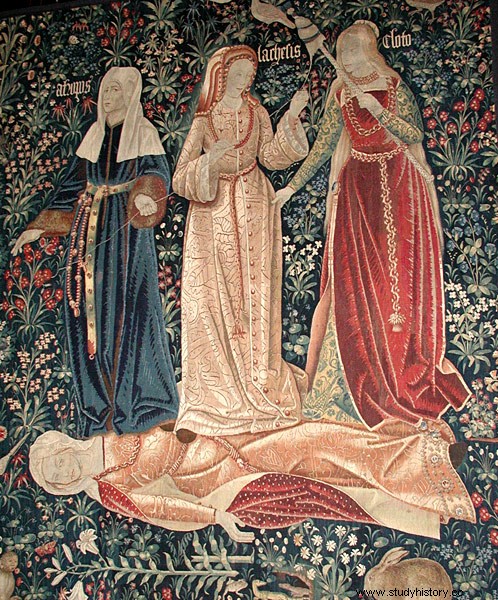
The Three Fates , Clotho, Lachesis, and atropos, which spin, pull out and cut the thread of life.
Word Origin
The word fe comes from the Latin word fata , which means fate and is also the name of the Goddess of Destiny . The word destiny is derived from the Latin term destiny , which means "that which has been ordained (destined) or spoken". The preterite of fatum is headlights =to talk.
The term face comes down to us in its Old French form as fee (pronounced fay) . Fee becomes faie in Middle English. It is also spelled fay, which refers to "the land of the fairies", now called "faerie". In Spanish fairy is fairy and in Portuguese it is the Fada from Latin fata, which means destiny.
The word fata also means oracle . Fata can also be related to the Latin word cotton wool , which means to predict. Vates also means oracle, prophet and seer. Vates is the root word for the name Vatican . The Vatican was the place where pagan Roman priests communicated with the gods (eg fairies and spirits).
Types of fairies
Fee / Fay- A woman with special skills is sometimes called a fay. The word fee / fay as mentioned before comes from the Latin term fate , which means destiny, prophetic vision, oracle and fairy. In mythology, the goddesses of fate such as the moira, the norns, the furies and the gray ones (Graeae), are always depicted as three women. The number three represents the goddesses whose responsibility it was to distribute one's assignment in life and destiny. Each destiny had a duty to be the spinner, the meter and cutter of life. The number of three is considered a magic number; it represents the Triple Goddess of the moon. The triple goddess or moon goddess triad is made by " the virgin", "the mother" and "the crone", which represent the phases of the moon and the phases of life. The moon is also a very powerful symbol and witchcraft.
The terms fey and fee are also used on women with magical powers and skills such as Morgan le Fey from Arthur Legends.
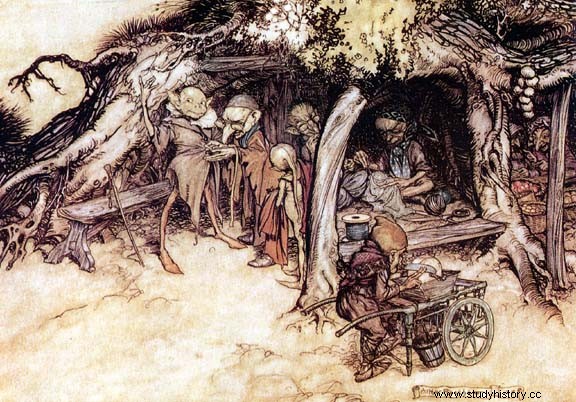
An illustration of elves from Shakespeare's A Midsummer Night's Dream by Arthur Rackham (Public Domain)
Elves, goblins and dawrves
The word elf comes from the Germanic words aelf and alp , which originally means spirit, nightmare, imp, incubus, goblin and white. While the term pixie is used to refer to a mischievous fairy. P ixie as a word comes from the legendary pictorial tribes of ancient Britain who painted their skin blue. But it may have originally come from the Scandinavian word for fe- pyske . It is also related to the Celtic pwca (puca, puka, bucca, puck, pyke) and the Old Norse vomit and puki, which all mean fairy.
In Spanish, the term is for an elf or dwarf is dwarf . It is from the Greek word nanus , which means dwarf or pygmy. It is also available in French as nain, as in Le Nain Rouge the famous " red devil" of Detroit. Duende is another Spanish word for elf and it comes from the term " dueno de casa "which means the true" owner of the house ". A duende was a type of household elf or spirit. is also related to the Swedish word tomte, which is a household elf, and means "housekeeper".
The Roman That House were also household spirits. The name Penates means "gods of the house" and comes from the Latin term penatus , which means a temple shrine or inner part of the house. The peanuts are usually associated with the temple of the goddess Vestia (Vesta / Hestia), the spirit of the fireplace and the household. Sprite is another term for a fairy. The word comes from the Latin word spirit and down in Old French as esprit and to English as spirit and sprite.
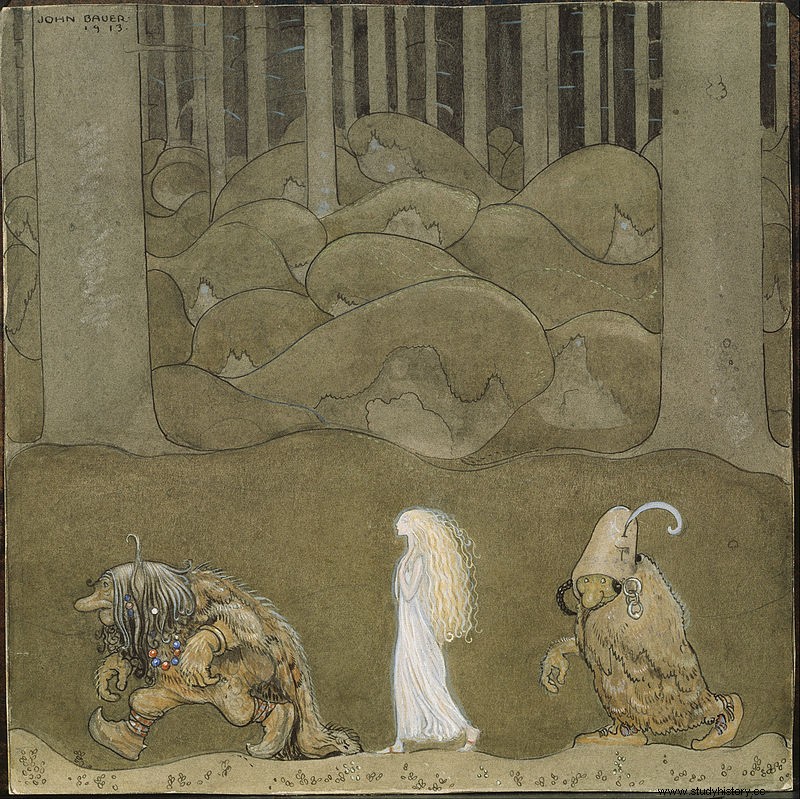
The Princess and the Trolls - The Changeling , By John Bauer, 1913 (public property)
Gnome- The word gnome comes from the Greek word genomos , which means someone who lives in the earth. It is also said to have been derived from the words gnomikos and gnosis , which means wisdom and knowledge.
Troll- A magical creature who is depicted as very tall and difficult. In some cases, trolls can also be very small. The term troll can go back to the old Scandinavian word trolla , which means to charm.
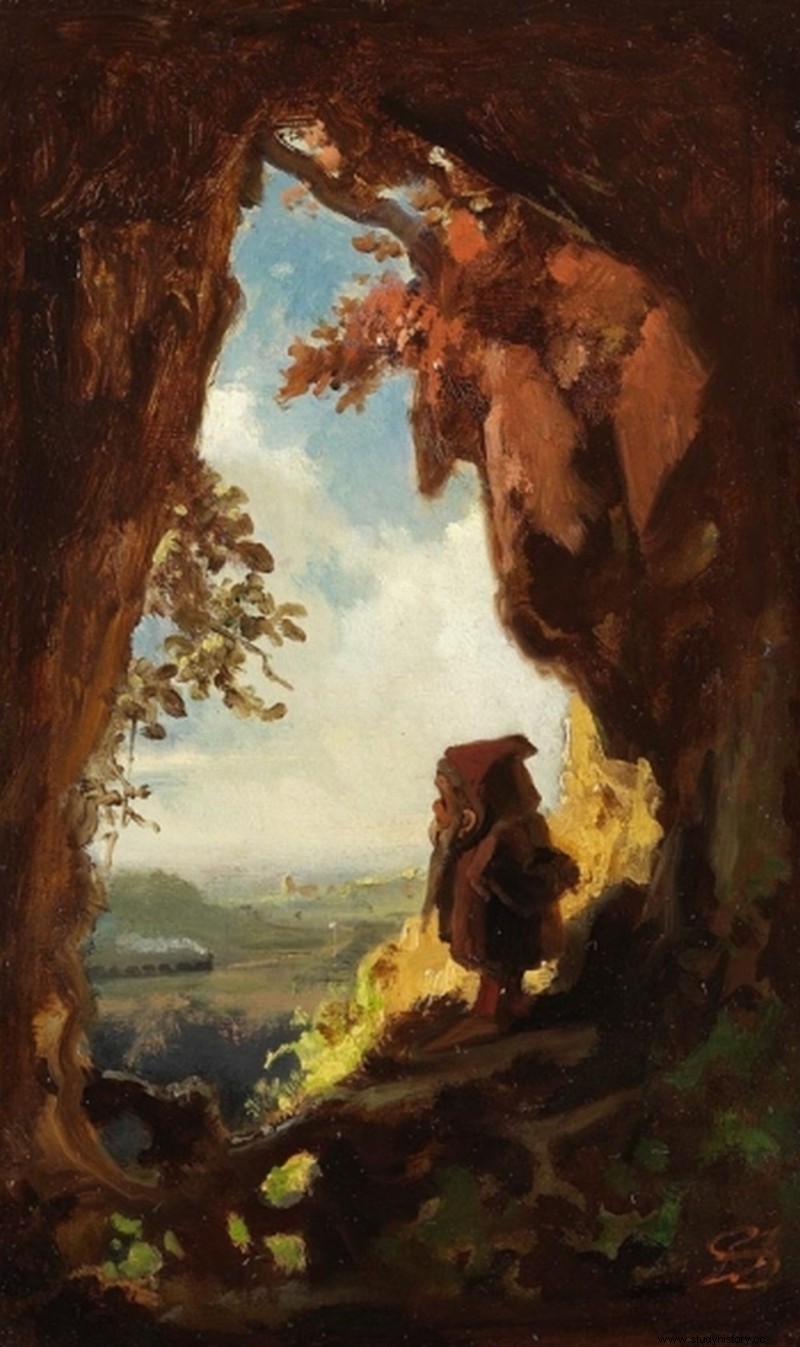
Gnome looks at railroad tracks, Carl Spitzweg, 1848 (public property)
Dryad- A dryad is a type of trident. The term is derived from the Greek words drus and druad , which means three. Druad, means three nymph . The word drus means tree and is related to the word druid. The term Druid may come from the Celtic word derwos (true), but it is more likely from the proto-Indo-European word Dru , which means tree and wid (uid, vid), which means to know or to see. A Druid was someone who had "knowledge of the tree" or knowledge of the dryad in the tree. Druids were said to have magical powers and an understanding of secret knowledge.
Sylph- A sylph is an air or forest spirit. The word sylf comes from the Latin word Sylvan , which means forest or forest.
Wights- The word wight comes from the Germanic language family. A wight (or "white") is another name for a spirit, a ghost, or any other type of supernatural, supernatural, or supernatural being. The term wight is also associated with the word weight , means creature and also a small child . Wight is also related to the Old Norse term vettir, means creature , which in turn led to the Swedish word vatte means earth spirit or nisse. The Danish name for a wight is vessen / vaesen, also means a creature or being.
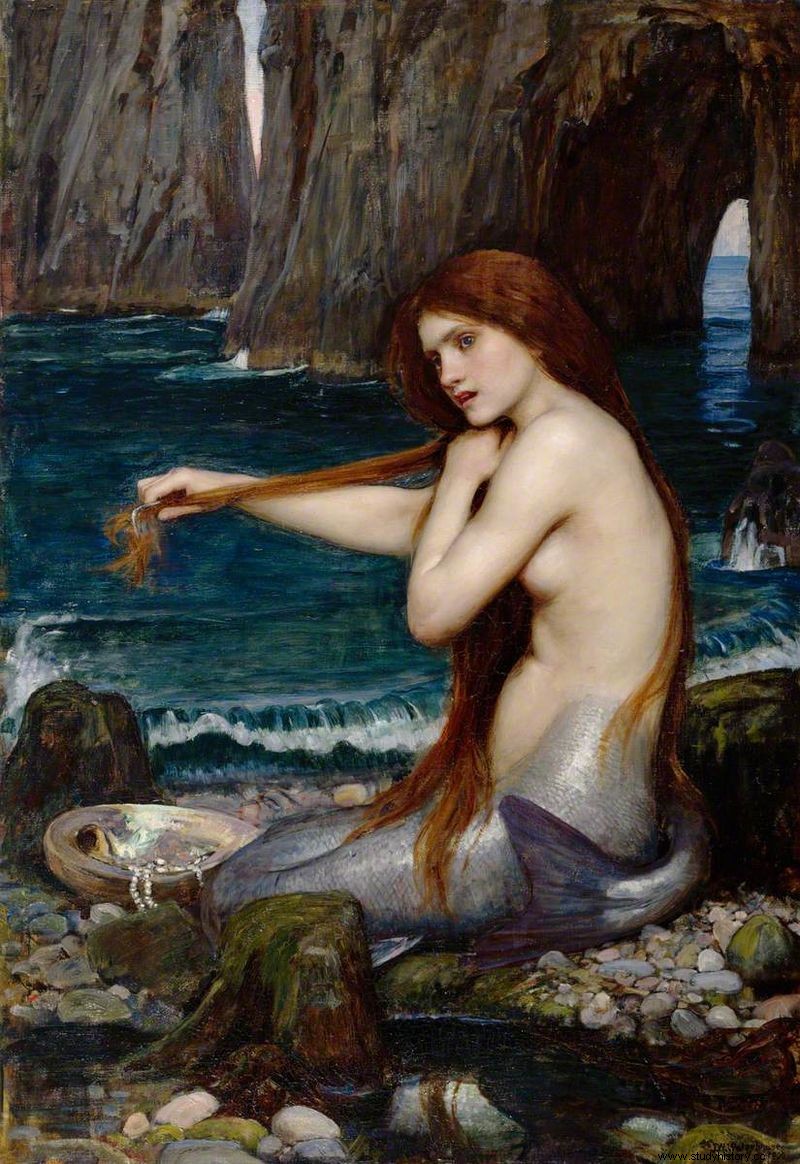
John William Waterhouse. A mermaid (public domain)
Mermaid and Sirens
A mermaid is a creature from mythology who is usually depicted as a woman with the lower body of a fish. Mermaids can be male (more-male) or female (more-maid). The term mermaid comes from the old English word only which is related to the Latin term jump and the Spanish word mar a and the French more, means sea. A maid, is another word for a woman or a girl. The term only may also be related to the proto-Indo-European term sea , which means to shine, shine and sparkle. More is also associated with an old Latin word merus , which means clean, naked and naked. Another word for a mermaid was Old English merewif, means a sea witch or a mythical woman living in the water.
Another type of mermaid is the siren. In legend, sirens were known to sing enchanting songs that caused shipwreck and drowning of sailors at sea. The term siren may have come from an ancient Greek word seira , which means to wrap, tie and rope. It is also related to the Latin term sirene / sirena and the Greek word seieren, which means mermaid. In Spanish, a siren is also a mermaid.
* Interesting how the old English term more-wife, was associated with the term a mermaid, but actually meant a mermaid .
Sea nymphs and nereids are creatures similar to mermaids. In Greek mythology, sea nymphs (water spirits) and nereids were demigods who were companions of the sea god Poseidon. Some had fishtail like a mermaid, while others did not. Nereids rode on the backs of dolphins and other sea creatures, such as how some fairies ride on the backs of butterflies, birds and flowers.
Description of fairies
Some fairies are human in appearance, while others are not. They also vary in size. The most common types of fairies have been described as from very small to the size of a small child. The smaller fairies are said to fly either with their own wings or on the backs of birds, butterflies, flowers, etc.
It is very common for fairies to be depicted as green eyes. In fact, the color green is associated with two types of fe-leprechauns and elves. The color green is most likely a natural symbol that the pagan spirit called "the green man". Wearing green clothes is also a way to camouflage yourself from people by interfering in the forest or the forest.
Most fairies are described as attractive and beautiful. Yet there are others who may be hideous or grotesque in appearance. Usually the grotesque types are trolls, trolls, goblins, etc. But do not be fooled, because beautiful fairies can also be evil.
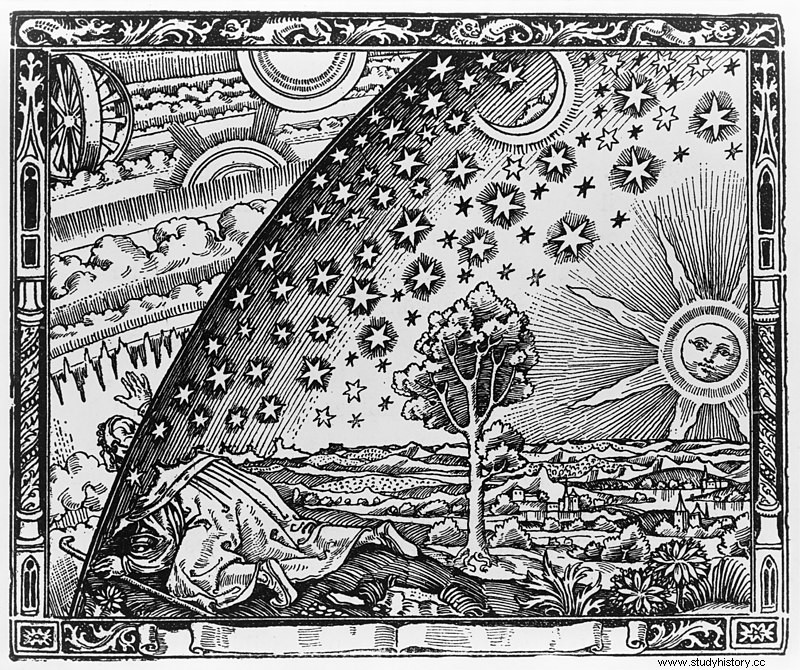
The Flammarion Engraving, Anonymous 1888 (public domain)
The Realm of Faerie (piles, rainbows, and mirrors)
Fairies live in a number of places, such as streams, trees or in underground mounds called sidhe. Faerie is the name of the kingdom in which the fairies live. It is believed that Faerie is another dimension that humans cannot penetrate unless they have a magic tool, the correct words (incantation), or have been invited there by the fairy. Another name for the holiday is Alfheim, which comes from Scandinavian mythology and literally means elf home .
Prav, Yav and Nav, are three mythical realms from Russian (and Ukrainian) mythology. Prav is the realm of the gods or divine beings who create a balance between the other two worlds. Yav corresponds to the earth (the material world) and Nav, is the invisible and intangible world. The dead spirits and other beings in the form of stars live in Nav. Fairies also live near rainbows, which are considered to be the bridge between the earthly kingdom and the kingdom of the gods. Rainbows are also known as the path that gods, spirits or other divine beings take to reach the earthly realm. In Greek mythology, Iris is the messenger of the gods, and her vehicle is a rainbow. In fact, in Spanish, a rainbow is called an "Arco de Iris or arcoiris", which means "Iris Bow".
The Mirror World
What do you think of when you see a mirror? The first thing I think of is a kind of reflection. Mirrors are used as a form of divination, and are also associated with parallel worlds, hidden realms and the occult. The root word for mirrors is I have to see and it means to see and to see . The root word mirare is also related to another word, mirari , means looking wondering or being amazed . The word mirari gave birth to the words miracle and mirrors .
A miracle is usually a wonderful supernatural event. Since ancient times, mirrors have been associated with the supernatural, and this is probably why smashing a mirror is considered bad luck. The mirror is the key or door to another realm and to break it means to cut off contact with the spirit world. In the story Through Serende Glass , Alice enters a parallel realm using a mirror. And, of course, that's the magic mirror in Snow White history. So we can say that mirrors have a supernatural quality to them, and can lead you into another world.
Why should we study fairies and related beings?
Fairies cross the boundaries of reality and myths. They provide a framework for the study of other similar topics and are also fun to read about. Our human mind claims to understand the complexity of life and tries to reconcile that reality with what some consider to be fantasy. Fairies are no longer just the subject of children's books, but are a serious study of culture, nature and society.
